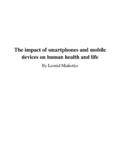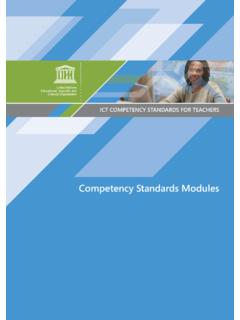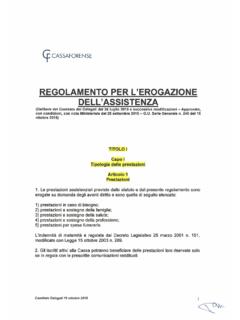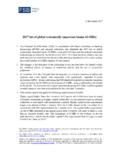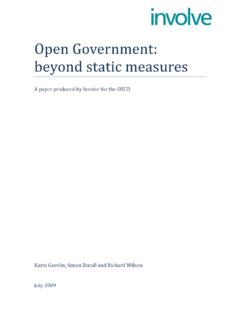Transcription of Plastic Waste - European Commission
1 Plastic Waste : Ecological and Human Health ImpactsNovember 2011 Plastic Waste : Ecological and Human Health Impacts Science for Environment Policy | In-depth Reports | Plastic Waste : Ecological and Human Health Impacts November 2011 ContentsExecutive Summary 1 Introduction Plastic Waste : Drivers and Pressures State of Plastic Waste in the Environment Impacts of plastics Waste on the Health of Ecosystems Responses 28 References 37 Figures1.
2 World plastics Production 1950-2008. From Plastic Waste in the 4 Environment. 2. Continued decoupling of Plastic Waste and landfill 5 3. Main sources and movement pathways for Plastic in the marine environment. 64. Proportion of post-consumer Waste in EU-27, Norway and Switzerland according to function, 2008. 75. Composition and numbers of marine litter items found on beaches within OSPAR network. 86. Changes in composition of marine items found on beaches within OSPAR network 97. Algalita Research Centre monitoring 108. Litter ( items/ hectare) on the sea bed in the channel (x) and the gulf of Lion (y) 1998 -2010 11 9.
3 Trends in the average number of marine litter items collected on reference beaches over three time periods 1210. Identity and compostition of Plastic debris collected from the strandline of the Tamar Estuary (UK) 1211. Amount of user and industrial Plastic in Fulmar stomachs in Netherlands over time 1412. EcoQO performance in North Sea regions 2005-2009 and preliminary trends. Trend shown by connecting running average 5 year data 15 13. Trends in EcoQO performance in different regions of the North Sea since 2002 (by running 5-year average data) 1514.
4 Number and percentage of marine species with documented entanglement and ingestion records 16 Plastic Waste : Ecological and Human Health Impacts Science for Environment Policy | In-depth Reports | Plastic Waste : Ecological and Human Health Impacts November 201115. Relationship between BPA concentrations in leachate and per capita GDP of Asian countries 2016. Illustration of additional effects of plastics in transport of phenanthrene 2217. Concentrations of PCBS in beached Plastic pellets 23 Plastic Waste : Ecological and Human Health Impacts Science for Environment Policy | In-depth Reports | Plastic Waste : Ecological and Human Health Impacts November 2011 Plastic Waste is a growing concern and the drivers behind it look set to continue.
5 Although recently there has been a slight decrease in Plastic production, this is unlikely to be maintained. Plastic is a highly useful material and its applications are expected to increase as more new products and plastics are developed to meet demands. The increased use and production of Plastic in developing and emerging countries is a particular concern, as the sophistication of their Waste management infrastructure may not be developing at an appropriate rate to deal with their increasing levels of Plastic Waste . Management of Waste in the EU has been improving in terms of recycling and energy recovery, but there is still much to be done.
6 At the heart of the problem is one of Plastic s most valued properties: its durability. Combined with the throwaway culture that has grown up around Plastic products, this means that we are using materials that are designed to last, but for short-term purposes. The state of Plastic Waste is notoriously hard to measure. It is estimated that in 2008 EU-27, Norway and Switzerland produced about megatonnes of Plastic Waste (Mudgal et al., 2011) but its distribution is difficult to ascertain. This is especially so in the marine environment where the constant movement of the oceans, both horizontally on the surface and vertically within the water column, make it difficult to develop an accurate picture.
7 Since the discovery of the Northern Pacific Garbage Patch, research has explored the gyres as areas of Plastic Waste accumulation, as well as beaches and river estuaries. There are a number of methods used to survey marine litter and currently there are initiatives to harmonise these. Several standardised surveillance guidelines have been developed, for example, those produced by the Oslo Paris Convention for Protection of the Marine Environment of the North-East Atlantic (OSPAR) and the United Nations Environmental Programme (UNEP). On land, there are few figures on the level of Plastic Waste and there is a need for more information on sources and possible pathways into the environment.
8 There has been increasing concern about the presence of microplastics, which are generally defined as Plastic fragments less than 5mm in size. These are produced either from the weathering of larger plastics or deposited directly as pre-consumer Plastic or from use in abrasives, such as those used in some cosmetics. Microplastics are particularly difficult to monitor and they may also have more influential impacts than larger impacts of Plastic Waste on our health and the environment are only just becoming apparent. Most of our knowledge is around Plastic Waste in the marine environment, although there is research that indicates that Plastic Waste in landfill and in badly managed recycling systems could be having an impact, mainly from the chemicals contained in Plastic .
9 In the marine environment, the most well documented impacts are entanglement and ingestion by wildlife. Other lesser-known effects are the alteration of habitats and the transport of alien species. Perhaps one of the most difficult impacts to fully understand, but also potentially one of the most concerning, is the impact of chemicals associated with Plastic Waste . There are several chemicals within Plastic material itself that have been added to give it certain properties such as Bisphenol A, phthalates and flame retardants. These all have known negative effects on human and animal health, mainly affecting the endocrine system. There are also toxic monomers, which have been linked to cancer and reproductive problems.
10 The actual role of Plastic Waste in causing these health impacts is uncertain. This is partly because it is not clear what level of exposure is caused by Plastic Waste , and partly because the mechanisms by which the chemicals from Plastic may have an impact on humans and animals are not fully established. The most likely pathway is through ingestion, after which chemicals could bioaccumulate up the food chain, meaning that those at the top could be exposed to greater levels of chemicals. Plastic Waste also has the ability to attract contaminants, such as persistent organic pollutants (POPs). This is particularly so in the marine environment since many of these contaminants are hydrophobic, which means they do not mix or bind with water.










